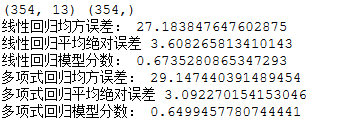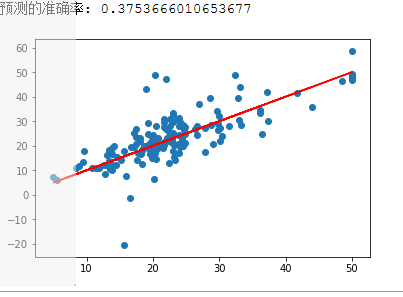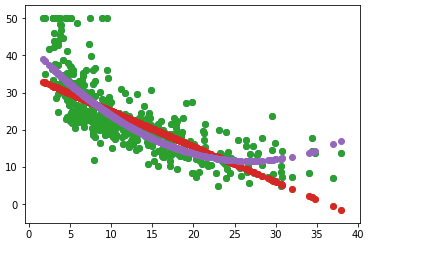from sklearn.datasets import load_boston #导入Boston房价数据集 boston = load_boston() #读取数据集 # boston.keys() #查看key值 x = boston.data y = boston.target #训练集与测试集划分 from sklearn.cross_validation import train_test_split x_train,x_test,y_train,y_test = train_test_split(x,y,test_size=0.3,random_state=0) #其中 test_size是样本占比,如果是整数的话就是样本的数量; #random_state是随机数的种子,不同的种子会造成不同的随机采样结果,相同的种子采样结果相同。 print(x_train.shape,y_train.shape) #建立一元线性回归模型 from sklearn.linear_model import LinearRegression lr = LinearRegression() lr.fit(x_train,y_train) lr.coef_ #系数 lr.intercept_ #截距 #检测模型好坏 from sklearn.metrics import regression y_pred = lr.predict(x_test) #预测 n = regression.mean_squared_error(y_test,y_pred) #预测模型均方误差 print("线性回归均方误差:",n) a = regression.mean_absolute_error(y_test,y_pred) print("线性回归平均绝对误差",a) s = lr.score(x_test,y_test) #模型分数 print("线性回归模型分数:",s) #多元多项式回归模型 from sklearn.preprocessing import PolynomialFeatures poly= PolynomialFeatures(degree=2) x_poly_train= poly.fit_transform(x_train) #多项式化 x_poly_test = poly.transform(x_test) #建立模型 lr2 = LinearRegression() lr2.fit(x_poly_train,y_train) #预测 y_pred2 = lr2.predict(x_poly_test) #检测模型好坏,计算模型的预测指标 n2 = regression.mean_squared_error(y_test,y_pred2) print("多项式回归均方误差:",n2) a2 = regression.mean_absolute_error(y_test,y_pred2) print("多项式回归平均绝对误差",a2) s2 = lr2.score(x_poly_test,y_test) print("多项式回归模型分数:",s2)

#多项式回归模型:建立13个变量与房价之间的预测模型,并检测模型好坏。 from sklearn.preprocessing import PolynomialFeatures poly=PolynomialFeatures(degree=2) from sklearn.linear_model import LinearRegression lineR=LinearRegression() x= boston.data y = boston.target x_train,x_test,y_train,y_test=train_test_split(x,y,test_size=0.3)#划分训练集和测试集 #多项式操作 x_train_poly=poly.fit_transform(x_train) x_test_poly=poly.transform(x_test) lineR.fit(x_train_poly,y_train)#建立模型 print('预测的准确率:',lineR.score(x_test_poly,y_test)) #图形化将元数据,一元拟合,多元拟合进行绘图观察 from sklearn.linear_model import LinearRegression import matplotlib.pyplot as plt lineR=LinearRegression() lineR.fit(x_train_poly,y_train) y_poly_pred=lineR.predict(x_test_poly) plt.plot(y,y,'r') plt.scatter(y_test,y_poly_pred) plt.show()

#3. 多元线性回归模型,建立13个变量与房价之间的预测模型,并检测模型好坏,并图形化显示检查结果。 import matplotlib.pyplot as plt x=boston.data[:,12].reshape(-1,1) y=boston.target plt.figure(figsize=(10,6)) plt.scatter(x,y) from sklearn.linear_model import LinearRegression lineR=LinearRegression() lineR.fit(x,y) y_pred = lineR.predict(x) plt.plot(x,y_pred) plt.show()

#4. 一元多项式回归模型,建立一个变量与房价之间的预测模型,并图形化显示。 from sklearn.preprocessing import PolynomialFeatures poly = PolynomialFeatures (degree=2) x_poly = poly.fit_transform(x) lrp = LinearRegression() lrp.fit(x_poly,y) y_poly_pred=lrp.predict(x_poly) plt.scatter(x,y) plt.scatter(x,y_pred) plt.scatter(x,y_poly_pred) plt.show()
